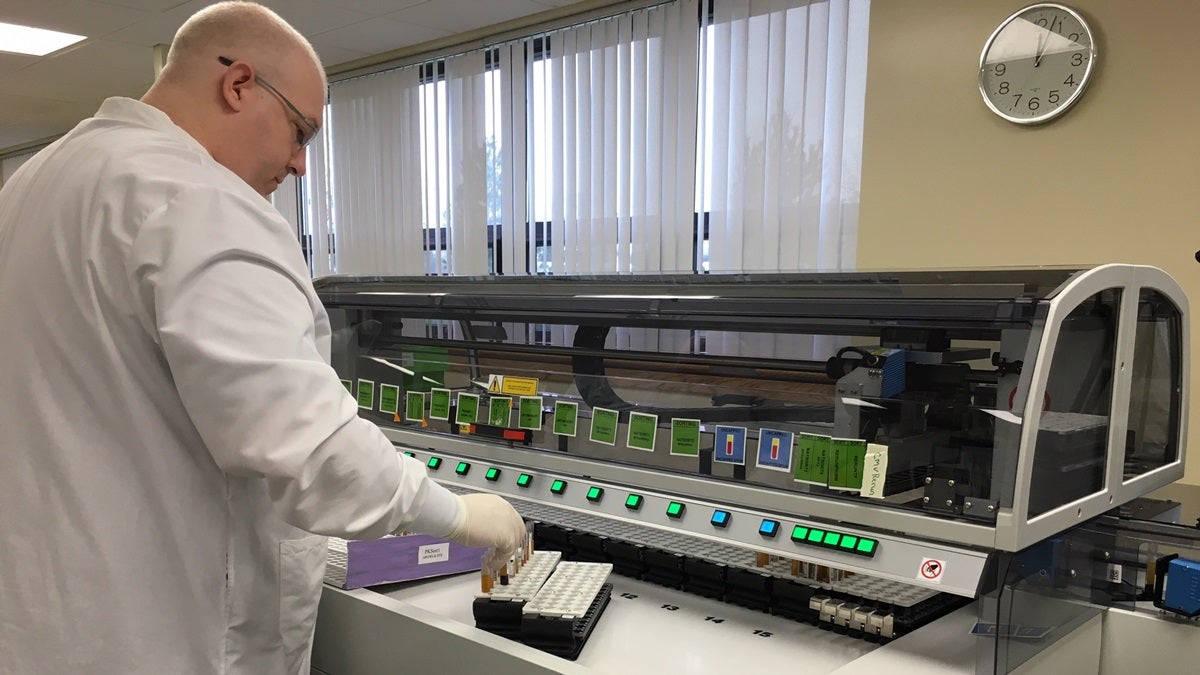Blood testing on the fast track in Delaware

A Blood Bank worker loads samples of blood into the new automated track system. (Mark Eichmann/WHYY)
New technology is helping the Blood Bank of Delmarva keep pace with a changing industry.
A handful of donors sit calmly in chairs giving blood and platelets in the front of the blood center as The Price Is Right plays on nearby TVs. It’s a quiet, serene atmosphere.
But further back in the Christiana facility, vials of donated blood and platelet samples are moving rapidly along an automated track system.
The vials are labeled with bar codes that are read by sensors on the track. The samples are then sent down the line to a location spelled out in the track’s computers. Another machine un-caps or recaps the samples. Some go to centrifuges to be spun. Others are discarded.
Previously, all this testing prep work had been done by hand. A much, much more time consuming process for the tests needed on hundreds of donations. “About 350 donors per day is what takes us to keep our hospitals in supply,” said Blood Bank Director of Marketing and Community Relations Michael Waite.
“The industry is changing drastically, and it’s hard to keep up,” said Lead Executive for Laboratory Services and Distribution Christopher Nare, noting that a number of blood centers around the country have shut down. “If we don’t continue to change and adapt, we won’t be able to be here long term for the community.”
Nare has led the charge to make the Blood Bank of Delmarva a leader in innovation. “We are the first blood center in the country to have an automated track in a donor screening lab,” Nare said. “It allows us to be more efficient, more competitive, and position ourselves to be a regional testing provider for not only Blood Bank of Delmarva, but other blood providers in the area.”
With that efficiency, Nare hopes to expand the Blood Bank’s footprint beyond the Delmarva Peninsula.
“If you look at where blood bank of Delmarva is located along the I-95 corridor and the proximity that we have to multiple airports in the region, if you just kind of look at the next 3 to 4 states, there’s anywhere from 350,000 to 500,000 blood donor samples that we could be testing here that aren’t being done here,” Nare said. He’s hopeful the improved efficiency provided by the automated track system will enable BBD to draw some of those samples from other blood centers.
In addition to the track system, the Blood Bank is also one of the first to utilize INTERCEPT, a new technology that uses ultraviolet light and Psoralen, a compound found in celery, to neutralize pathogens in donated platelets.
“They’ve used Psoralen with ultraviolet light that can inactivate those pathogens and keep them from growing and multiplying,” Nare said. “It essentially makes the platelet product safer and minimizes the chance that a patient can get some kind of bacterial pathogen infection from the platelet product.”
“All of this is driven for one thing and one thing only, and that’s patient safety, donor safety,” Waite said.
Being able to inactivate pathogens in the platelets also has another benefit. “It moves from trying to test for everything or continuing to add tests,” Nare said. “I think over time we’ll be doing less tests.”
The INTERCEPT treatment could also enable donated platelets to stay on hospital shelves longer, extending the supply. “That could be a game changer,” Waite said. “That could take that five day window and increase it to seven days. And you can imagine with 48 hours more, with an opportunity to use that product, the big difference it could make.”
January is National Blood Donor Month, and the Blood Bank of Delmarva says out of 35 percent of the population who are eligible to donate, just 4 or 5 percent roll up their sleeves to give. They obviously would like to see that number increase and say they’re willing to answer any questions or concerns people may have about being a blood donor.
WHYY is your source for fact-based, in-depth journalism and information. As a nonprofit organization, we rely on financial support from readers like you. Please give today.





